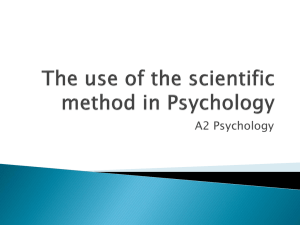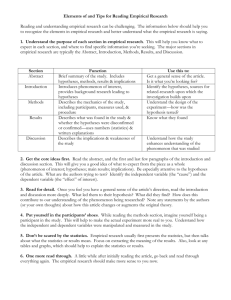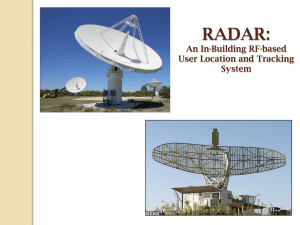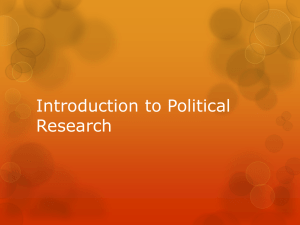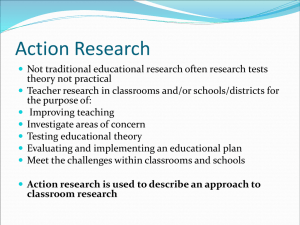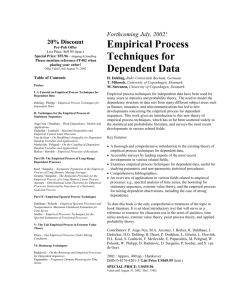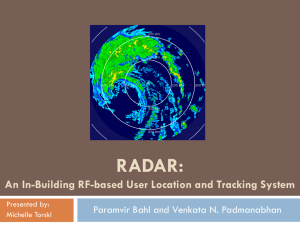The use of the scientific method in Psychology advs and
advertisement
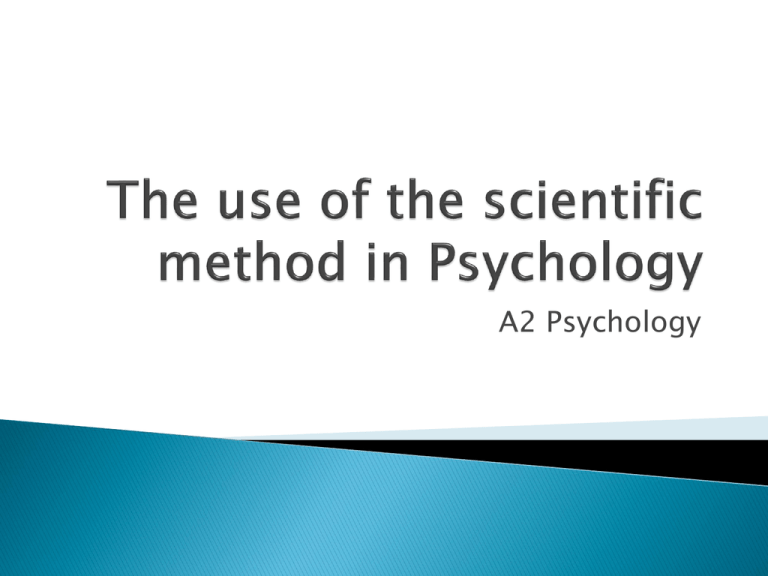
A2 Psychology Psychologists, like all scientists, use the Scientific Method to produce valid explanations of the world around them. This method has both advantages and disadvantages. The Scientific process starts with observations of phenomena in the world. In the Inductive Model this then leads to the developments of hypotheses. Hypotheses are tested which may lead to new questions and new hypotheses. Eventually such data may be used to construct a theory. The Deductive Model theory construction at the beginning of the process, after making observations. Example: the spontaneous generation theory Life emerges from nonliving matter Make Observations Reject the theory No mice!!!! Place dirty socks in a glass jar for a few days Mice emerge from dirty socks Hypothesis Experiment Deductive process Inductive process Theory Referring back to the definition of ‘Scientific’, any research can be considered scientific as long as it collects data in an objective, controlled manner. The following research methods have been put in order of how scientific they are considered to be. Lab Experiments Field Experiments Natural Experiments Interviews/Questionnaires Observations The left picture is a burger from McDonalds. Or it is at least what you are led to expect you will get. What about reality? You may think you know something but unless you test this empirically you cannot know if it is true. The right picture is the empirical evidence of what the burgers are really like. So what is Empirical Data? Empirical data is information gained through direct observation or experiment rather than reasoned argument or unfounded beliefs. The Scientific aims to collect the facts. Why is this an advantage? People can make claims about the truth of a theory or the benefits of a treatment but the only way we know such things are true is through empirical evidence. An important aspect of empirical data is that they are objective. What does this mean? That the data is not affected by the expectations of the researcher. Systematic collection of measurable data is at the heart of the method. How would an experimenter allow for greater objectivity? Usually via standardised procedures and instructions. Why is this an advantage? Without objectivity we have no way of being certain that data collected is valid. The aim of the Scientific Method is to test hypotheses by falsifying them. i.e. rejecting a null hypothesis. Why is this an advantage? Because it is not possible to prove a hypothesis correct but you can prove it is wrong. i.e. falsify it. “no amount of observations of white swans can allow the inference that all swans are white, but the observation of a single black swan is sufficient to refute that conclusion” The ideal form of the scientific method is a lab experiment because is enables the researcher causal relationships. What is a causal relationship? Showing cause and effect. The experimental method is the only way to do this – where we vary one factor (independent variable) and observe it’s effects on the a dependent variable. In order for this to be a ‘fair test’ all other conditions must be controlled, and the best place for this is in a lab setting. What are extraneous variables? Any other variables apart from the IV that could in truth affect the DV. Why is this an advantage? If we can’t demonstrate causal relationships then we can’t be sure, for example, a person’s anxiety was reduced by the drug used. Scientists record their methods and standardise them carefully so that the same procedures can be followed in the future. i.e. replicated. Why is this an advantage? Repeating a study is the most important way to demonstrate the reliability and validity of an observation or experiment. If the outcome is the same this affirms the truth of the original results. In pairs You need to come up with as many advantages for each study you can think of and relate back to the advantages of the Scientific Approach. Milgram’s (1963) study on Obedience. Asch’s (1951) study on Conformity. Selye’s (1935) study on Stress Loftus and Palmer’s (1974) study on Eyewitness Testimony. Gibson and Walk’s (1960) study of Depth Perception. APFCC for following studies:Milgram’s (1963) study on Obedience. Asch’s (1951) study on Conformity. Selye’s (1935) study on Stress Loftus and Palmer’s (1974) study on Eyewitness Testimony. Gibson and Walk’s (1960) study of Depth Perception. Gardner and Gardner, Language acquisition in a chimp. 1. 2. One advantage of the scientific method is that it is objective……….. a) Describe how Gardner and Gardner’s study is objective b) Why does the fact that it is objective make the findings more convincing? Another advantage of the scientific method is that it is empirical……… 2. a)Describe how Asch’s study is empirical b) Why does that fact that it is empirical make the findings more convincing? 1. 1. Another advantage of the scientific method is that the theories are falsifiable 2. a)Describe how Selye’s research is falsifiable b)Why does this falsifiability make the findings more convincing? 1. Another advantage of the scientific method is that research is replicable 2. a)Describe why Milgram’s research is replicable b) Why does the fact that the research is replicable make the findings more convincing? 1.Another advantage of the scientific method is that it is controlled i.e lab experiment 2. a) Describe why Loftus and Palmer’s research was controlled b) Why does the fact that the research is controlled make the evidence more convincing? Cause and Effect The Scientific Method lets us state that it is the IV causing changes in the DV. Quantitative Data This can be collected and then be analysed using descriptive and inferential statistics tests, which can then be used to prove or disprove a hypothesis. Participants With Scientific methods, especially lab experiments, you can choose the participants that best represent your target population. Problems include:Situational variables Participant variables Demand characteristics Why is this a disadvantage? The observed effects may be due to variables other than the IV. Ecological validity is a problem when artificial settings are used. Why is this a disadvantage? Findings cannot be generalised to the real world phenomena Operationalised variables in experiments and behavioural categories in observations reduce the complexity of behaviour. Why is this a disadvantage? Explanations of behaviour become oversimplified. The nomothetic approaches looks to generalise findings to all people. Why is this a disadvantage? Uniqueness and difference between genders, cultures and ages are ignored. Experimental and observation methods often involve psychological harm and deception which is seen as necessary to maintain scientific rigour. Why is this a disadvantage? Participants may be harmed Psychology could be brought into disrepute. Investigator affects The scientific method does not acknowledge that subjectivity of the researcher can affect the results. Cultural/gender biases A necessity to be able to generalise scientific findings means that they could be ethnocentric/androcentric. Read through the example essays and highlight and identify the key advantages/disadvantages. Highlight in a different colour where the person has used examples of research to support their arguments Highlight in a different colour linking/signpost words used to give the essay good structure. Identify three things that you have learnt/found useful from reading these essays You are going to complete an essay each by building on the points already made by others. This is how:Everyone write an introduction to the question:- Discuss the advantages of using the scientific method in psychology (15) Write one point including one advantage, reason why it’s good and an example -pass your essay on. Read the comments already written and write the next point then pass it on. Do this until we have 5 points. Return the essays to the original writer and mark them using the handout with the bubbles.
